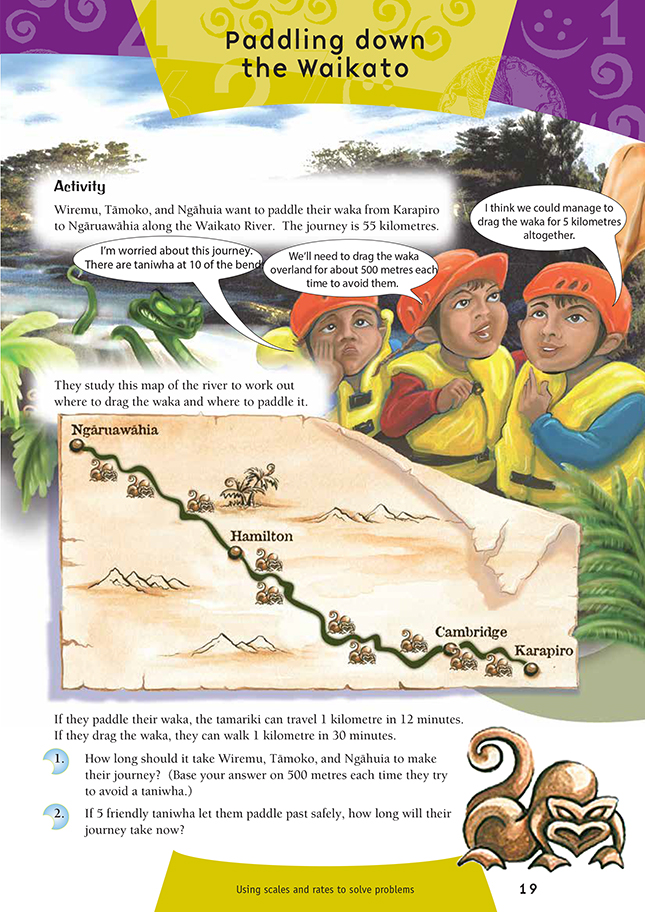This is a level 5 number activity from the Figure It Out series. It relates to Stage 8 of the Number Framework.
A PDF of the student activity is included.
Click on the image to enlarge it. Click again to close. Download PDF (260 KB)
use scales and rates to solve problems
FIO, Level 3-4, Number, Book 2, Paddling down the Waikato, page 19
This activity includes questions on length, time, and rates. It builds on the previous page in that it uses number sense and number calculations to make calculations involving rate. Students who are advanced additive could answer the rate questions using strategies such as repeated addition. In this case, such strategies will work, but they will be inefficient. Students who are advanced multiplicative and beyond should be using multiplication strategies for most of the questions.
Most students will assume for question 1 that the paddlers will try and avoid all the taniwha. Each bend, whether paddling or dragging, is assumed to be 500 metres, and the total journey is 55 kilometres. The total time travelled = number of 500 metres walked x 15 minutes + kilometres paddled x 12 minutes.
If Wiremu, Tāmoko, and Ngāhuia drag the waka overland for 10 bends, they will walk 10 x 500 metres (5 kilometres). It takes 15 minutes to drag the waka over each 500 metres: 10 x 15 minutes = 2 hours 30 minutes. This leaves 50 kilometres (55 – 5 = 50) to paddle.
Total time = 2 hours 30 minutes + 50 x 12 minutes
= 2 hours 30 minutes + 10 hours
= 12 hours 30 minutes
In question 2, the students take into account the effect of the 5 friendly taniwha, but they can use similar reasoning to that for question 1.
You could use the information on the page to explore various scenarios of walking versus paddling. Encourage the students to justify their answers with mathematical information. For example, “We made them walk 5 bends. That’s 21/2 kilometres, so that would take 1 hour 15 minutes. That leaves 52.5 kilometres to paddle at the rate of 12 minutes per kilometre, so that would take 10 hours 30 minutes. So the total time would be 11 hours and 45 minutes.”
You could give the students a blank version of this table to fill in:
The table allows the students to see the relationships between the times and distances. It can also be used to develop an algebraic formula that describes the relationship between the distance walked and the time taken and the distance paddled and the time taken (using kilometres and minutes).
For example, when comparing the distance walked and drag time: “What do you multiply 1 by to get 30? 2 by to get 60? 2.5 by to get 75?” (The students should be able to identify the factor of 30.)
When comparing the distance paddled and the paddle time, ask: “What do you multiply 55 by to get 660?” (12) “Does this factor work for all the relationships?” This can be quickly tested with a calculator by multiplying all the distances paddled by 12. (This will establish the relationship if the students are struggling with the mental calculations.)
Total time in minutes = 30 x distance walked (kilometres) + 12 x distance paddled (kilometres).
Answers to Activity
1. 12 hrs 30 min, assuming they avoid all 10 taniwha. (If they dragged the waka for about 500 m round each bend where there is a taniwha, that would take them 150 min. They would paddle for 50 km: 50 x 12 min = 600 min. 150 + 600 = 750 min, which is 12 hrs 30 min.)
2. With 5 friendly taniwha letting them paddle past safely, they would only drag the waka around 5 stretches of 500 m (5 x 15 = 75 min) and paddle for 52.5 km (52.5 x 12 = 630). 75 + 630 = 705 min, which is 11 hrs 45 min.

